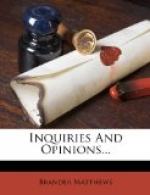The inquirers who should read his stories in the strict sequence of their production could not fail to be struck with the first awakening of his curiosity about human feeling; and they might easily trace the steady growth of his interest in psychologic states. Telling us at first bluntly and barely what his characters did, he came in time to find his chief pleasure in suggesting to us not only what they felt, but especially what they vaguely feared. Toward the end of his brief career the thought of death and the dread of mental disease seemed to possess him more and more with a haunting horror that kept recurring with a pathetic persistence. He came to have a close terror of death, almost an obsession of the grave; and to find a parallel to this we should have to go back four hundred years, to Villon, also a realist and a humorist with a profound relish for the outward appearances of life. But Maupassant went far beyond the earlier poet, and he even developed a fondness for the morbid and the abnormal. This is revealed in ’Le Horla,’ the appalling story in which he took for his own Fitzjames O’Brien’s uncanny monster, invisible, and yet tangible. In the hands of the clever Irish-American this tale had been gruesome enough; but the Frenchman was able to give it an added touch of terror by making the unfortunate victim discover that the creature he feared had a stronger will than his own and that he was being hypnotized to his doom by a being whom he could not see, but whose presence he could feel. There is more than one of these later tales in which we seem to perceive the premonition of the madness which came upon Maupassant before his death.
At first he was an observer only, a recorder of the outward facts of average humanity. He had no theories about life, or even about art. He had no ideas of his own, no general ideas, no interest in ideas. He did not care to talk about technic or even about his own writings. He put on paper what he had seen, the peasants of Normandy, the episodes of the war, the nether-world of the newspaper. He cared nothing for morality, but he was unfailingly veracious, never falsifying the facts of existence as he had seen it himself. Then, at the end, it is not what his characters do that most interested him, not what they are, not what they think, but what they feel, and, above all, what they fear.
In every work of art there are at least four elements, which we may separate if we wish to consider each of them in turn. First of all, there is the technic of the author, his craftsmanship, his mastery of the tools of his trade; and by almost universal consent Maupassant is held to be one of the master craftsmen of the short-story. Second, there is the amount of observation of life which the author reveals; and here again Maupassant takes rank among the leaders, altho the sphere in which he observed had its marked limitations and its obvious exclusions. Thirdly, there is the underlying and informing imagination which




